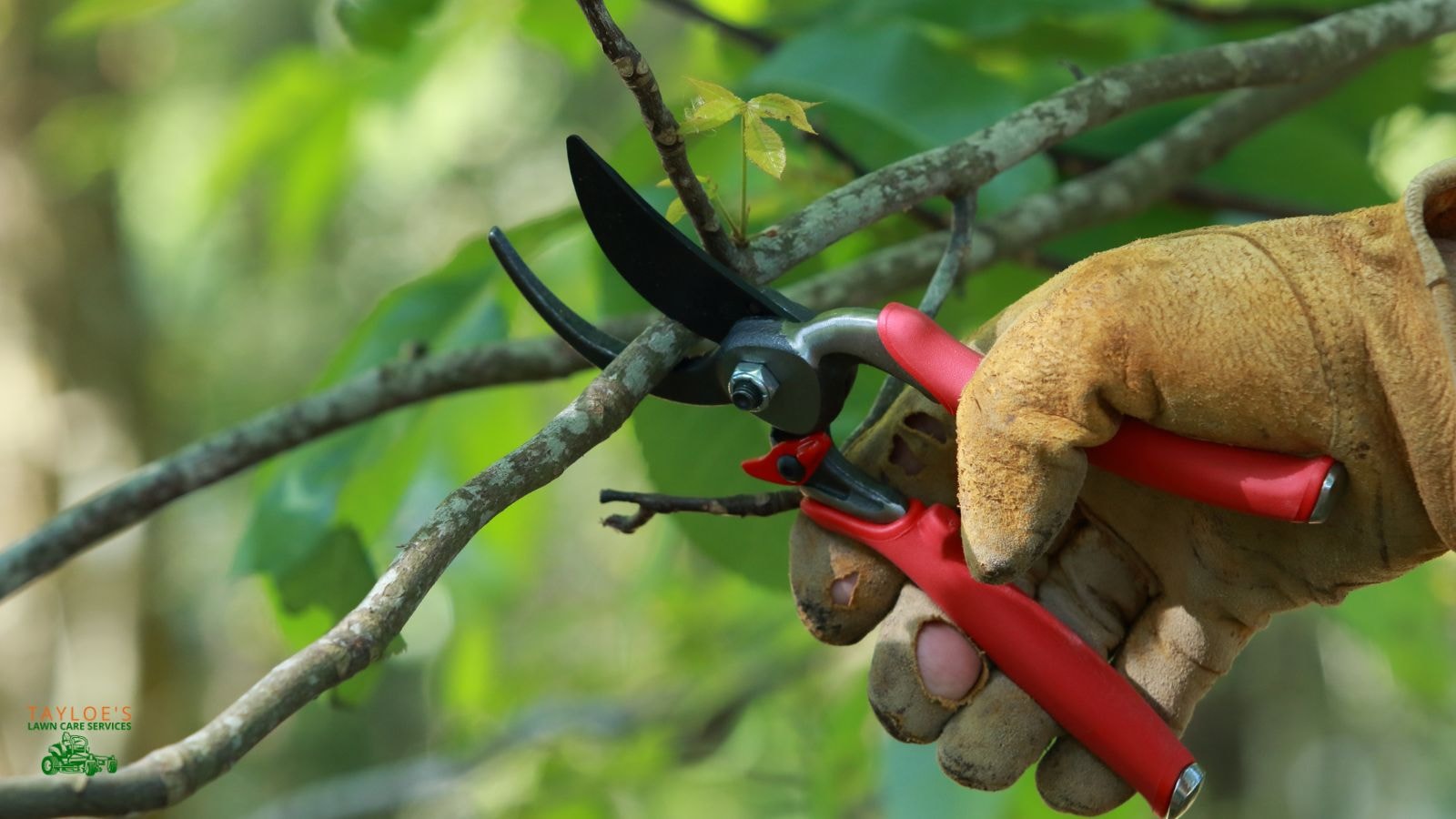Last Updated on: 26th November 2024, 06:45 am

Here’s why you should effectively disinfect pruning tools after every use.
Pruning shears may look innocent, but they can secretly carry diseases that wreak havoc in your garden. Each cut risks spreading pathogens that stunt, weaken, or even kill your plants. The good news? If you disinfect pruning shears or other garden trimmers and other tools can stop these invisible threats before they cause harm. Let’s explore why it’s essential to disinfect your pruning tools—and how to do it effectively.
Why Disinfect Garden Tools?
Gardening tools can unintentionally spread plant diseases if left unclean. Sap, soil, and plant debris stuck to blades and prongs often harbor harmful pathogens, which can transfer from one plant to the next through pruning cuts or soil contact, triggering a cycle of infection.
When pruning diseased plants, these pathogens can spread even more aggressively, putting the rest of your garden at risk.
Disinfecting your tools after finishing pruning and before moving on to the next plant is a simple but essential habit to stop these pathogens in their tracks. It helps prevent the spread of fungi like powdery mildew and bacteria such as Agrobacterium tumefaciens, the culprit behind bacterial crown gall—a disease that stunts or kills plants with tumor-like growths.
Disinfecting also protects your pruning tools. Sticky sap and grime dull blades, jam hinges, and cause rust. Clean tools make smoother cuts, reduce plant stress, and last longer—saving you time and money.
The 5 Effective Disinfectants for Pruning Shears (& Other Garden Tools)
Properly disinfecting your pruning shears and garden tools is key to preventing the spread of plant pathogens and maintaining a healthy garden. Here’s a closer look at five effective disinfectants and how to use them:

1. Bleach Solution
Bleach, a household staple containing 5.25% sodium hypochlorite, is a powerful and affordable disinfectant for garden tools. However, its corrosive properties make it less suitable for pruning tools that require a sharp edge, as it can cause pitting and nicks in the metal.
Bleach is best reserved for large hand tools like shovels, spades, and rakes, or for disinfecting stakes, tomato cages, poles, trellises, and large containers.
To prepare a bleach solution, mix one part bleach with nine parts water in a plastic container large enough to immerse your tools. Never mix bleach with anything other than water or laundry detergent, as doing so can release harmful fumes.
How to Use Bleach to Disinfect Pruning Shears:
Begin to by cleaning off all visible dirt and other debris from your tools.
Dip, douse, or spray your tools with the bleach solution, ensuring all parts are thoroughly treated. For taller items, turn them over in the container to cover every surface.
Allow the tools to dry completely before storing.
To protect metal tools, rub them with a light coating of linseed oil, Tung oil, or mineral oil after drying. This helps prevent rust. If rust does appear, use steel wool or a wire brush to remove it before reapplying oil.
2. Rubbing Alcohol
Rubbing alcohol, particularly 70% isopropyl alcohol, is a quick and efficient disinfectant for garden tools. It can instantly kill fungi, bacteria, and viruses, making it ideal for cleaning tools between plants. However, it may not combat certain diseases, such as fire blight on apple trees infected.
To disinfect, dip the blades in alcohol, wipe them with an alcohol-soaked cloth, or apply it evenly using a spray bottle. Use a paper towel to remove dirt or plant sap clinging to the blades. Spray the blades again, but this time, let the alcohol dry naturally.
Allowing the tools to air dry ensures the alcohol has enough time to sterilize the blades and eliminate any remaining pathogens—no rinsing is needed.
While rubbing alcohol is affordable and widely available, prolonged use can dry out rubber or plastic components on your tools. Always handle it with care, keeping it away from flames and using it in a well-ventilated area.
3. Hydrogen Peroxide
Hydrogen peroxide is a gentler, eco-friendly disinfectant, ideal for regular use on pruning shears and other gardening tools. A 3% solution effectively eliminates pathogens without the corrosiveness of bleach, helping to prevent the transfer of harmful microbes that can spread disease in your garden.
To use, generously spray the solution onto tools or soak them for several minutes. Rinse with water if needed, and dry thoroughly to avoid moisture-related damage.
Hydrogen peroxide is non-toxic and widely available but works more slowly than rubbing alcohol or bleach. For best results, use freshly opened hydrogen peroxide, as it loses potency when exposed to light and air.
4. Heat Treatment
Heat is a natural and chemical-free way to sterilize pruning tools and other garden equipment. Boiling, steaming, or baking kills most pathogens effectively. Boil or steam tools for a few minutes or bake them in the oven at 180°F to 200°F for about 30 minutes. This method works best for small, all-metal tools without plastic components, as high heat can cause plastic to melt.
Heat treatment is ideal for occasional deep cleaning, but it requires careful handling. Always wear gloves or use tongs to handle hot equipment, and ensure they’re completely dry before storage to avoid rust.
5. Household Cleaners
Pine-Sol, Listerine, and Lysol are sometimes used to sterilize pruning tools, though their effectiveness against plant pathogens isn’t scientifically proven. Many gardeners appreciate their convenience for general cleaning, but these products are less reliable than isopropyl alcohol or bleach for thorough disinfection.
Some household cleaner, if not appropriately rinsed, corrodes metal over time, causing rust and significant damage. To protect your tools, always rinse and dry them thoroughly after use.
Tips for Maintaining Clean Pruning Shears
Proper maintenance is crucial for keeping your pruning and cutting tools in top shape. Here are a few other tips for when it’s time to disinfect pruning shears:
Clean garden tools after each use; wipe away sap and debris to remove dirt and prevent buildup.
Sterilize with rubbing alcohol or hydrogen peroxide between cuts to prevent the spread of pathogens.
Sharpen blades regularly for clean, precise cuts, and apply a light coat of oil to discourage rust and ensure smooth operation.
Store the shears and other pruning tools in a dry, protected space with a blade cover to avoid moisture damage.
Disinfecting Pruning Tools is More than Just a Routine Task…
When you disinfect pruning shears, you are protecting the lifeblood of your garden. A few simple steps can prevent plant diseases, save your garden implements from rust and wear, and ensure every cut you make supports healthy growth.
Incorporating effective disinfection methods and routine maintenance into your gardening habits’ll keep your tools sharp, your plants vibrant, and your garden thriving. Your effort today is an investment in a flourishing, disease-free garden tomorrow.
Clean garden tools. Healthy plants. A garden that thrives—start today. Love these ideas?
Author Profile

- Maureen Abuor
- Maureen Abuor is a professional content marketing strategist and SEO strategist, with particular knowlege of creating landscaping and gardening content that informs and delights her audience. When she's not working, she's a busy mother of three precious little ones and child of God.
Latest entries
 Lawn CareApril 29, 2025Best shady area grass seed for Eastern NC
Lawn CareApril 29, 2025Best shady area grass seed for Eastern NC GardeningApril 15, 2025How do I make organic soil for the garden?
GardeningApril 15, 2025How do I make organic soil for the garden? Flower GardenMarch 7, 2025What are wave petunias?
Flower GardenMarch 7, 2025What are wave petunias? Flower GardenMarch 3, 202520 Full-sun annuals for your spring and summer garden
Flower GardenMarch 3, 202520 Full-sun annuals for your spring and summer garden








